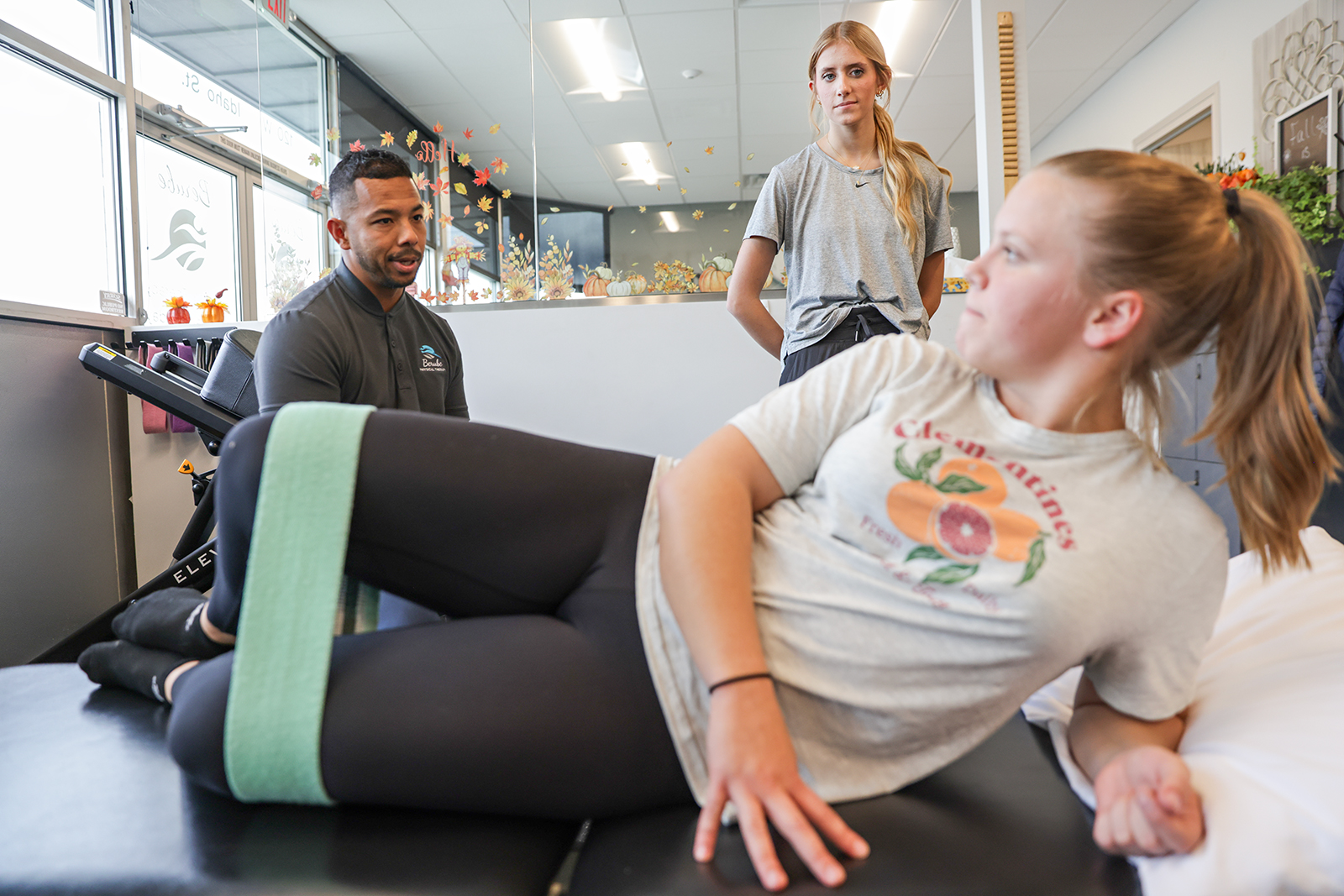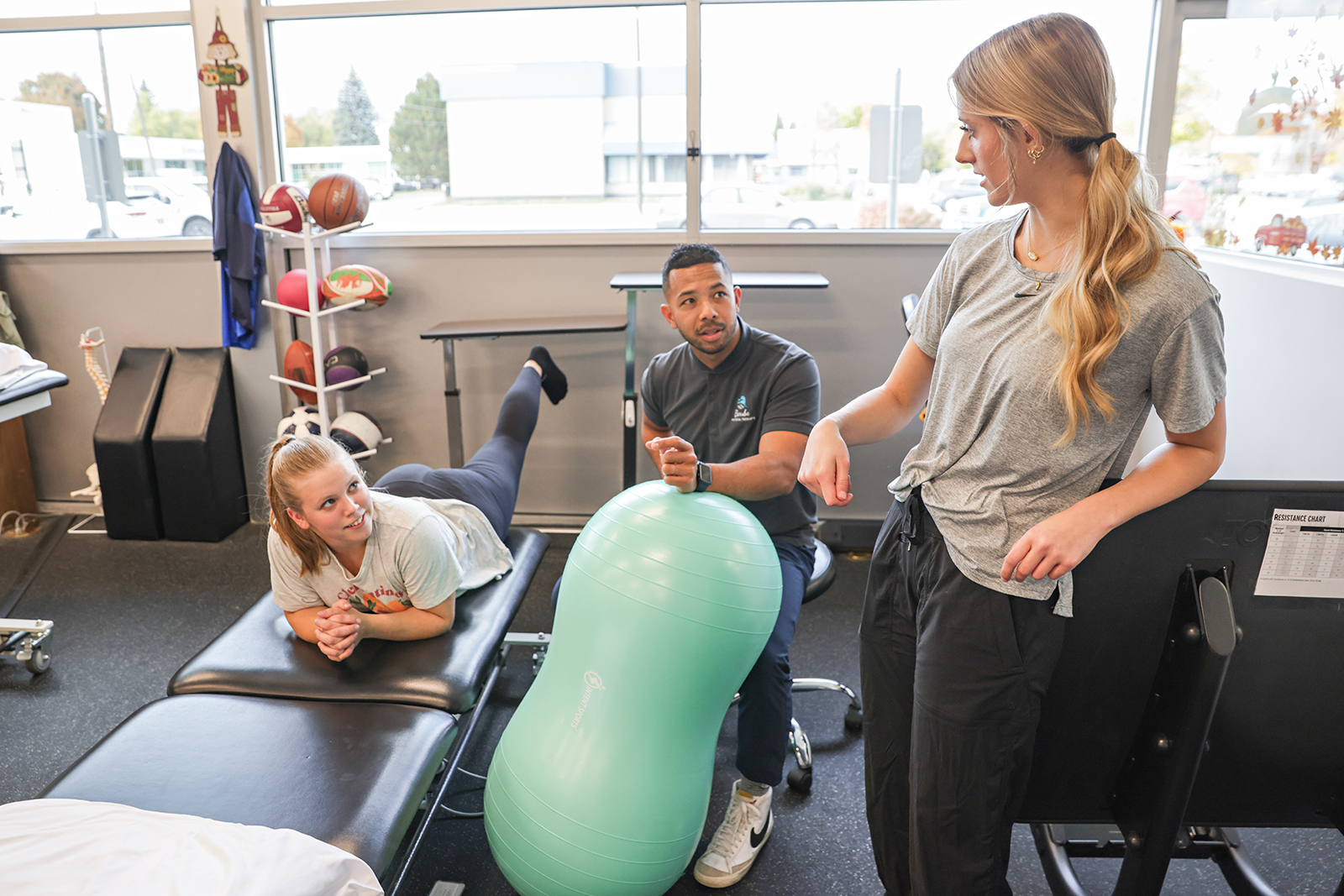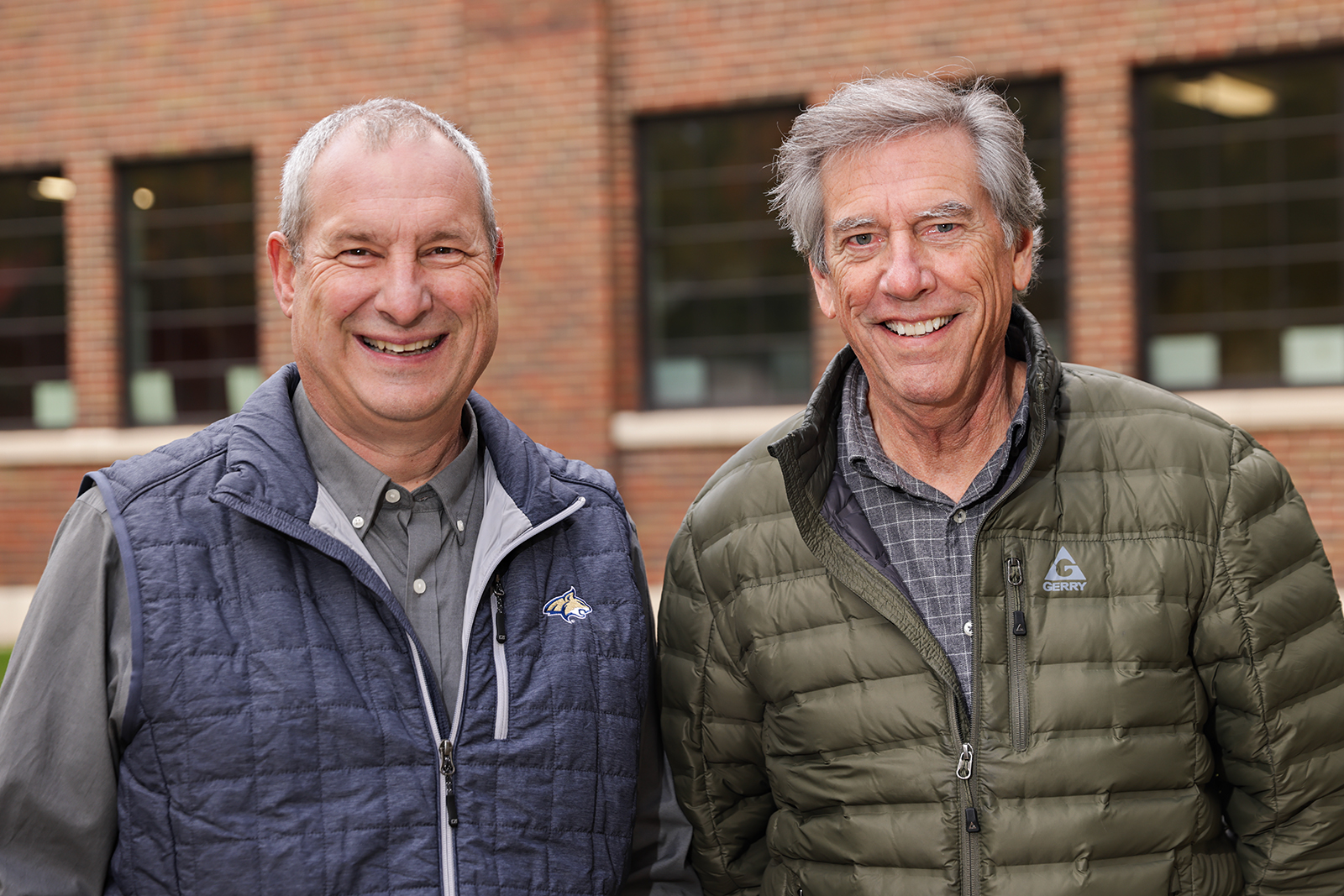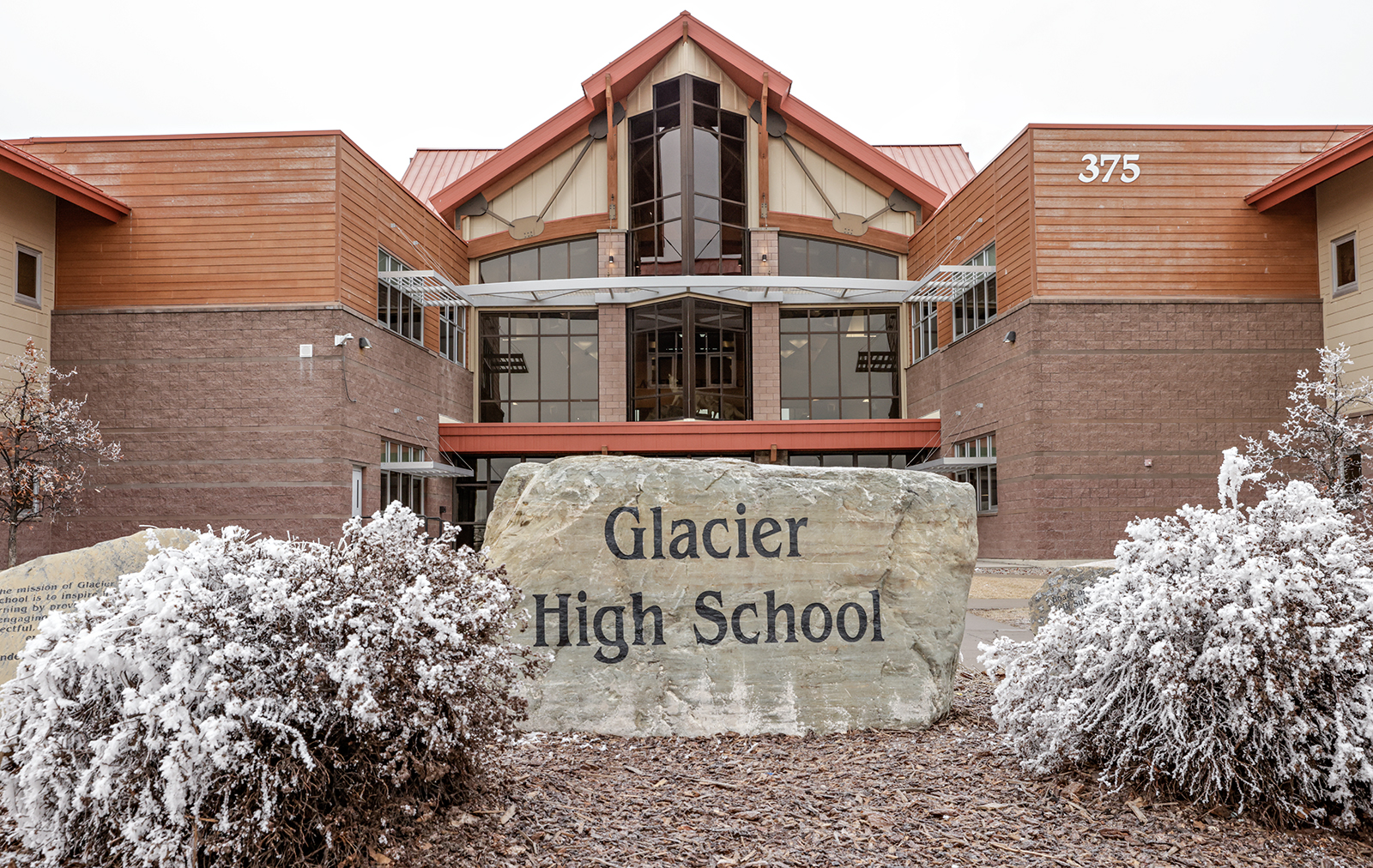Kalispell Public Schools’ Work-Based Learning Program Becoming ‘Part of Our Culture’
The program served as a key factor in the district’s successful levy campaign last spring and Gov. Greg Gianforte recently lauded the program during a roundtable conversation with the U.S. Education Secretary
By Mariah Thomas
As Kalani McLaughlin, a physical therapist with Berube Physical Therapy, advised Anouk Lee, his patient, about the recovery process for her upcoming ACL surgery, Cassidy Dennison listened and watched.
Dennison, a Flathead High junior, spends two days per week in the clinic, surrounded by workout machines and learning what exercises help patients with their goals or challenges. In Lee’s case, McLaughlin explained, they were working on low-impact exercises to keep her strong ahead of her surgery. He handed her a resistance band to put around her knees. Dennison stood watch as Lee did a series of clamshell exercises, lifting one knee up and putting it down before switching to the other side. When Lee finished, Dennison took the band from her and put it away.
Dennison’s interest in the health care field first piqued when she took a bio-med class at Flathead High School. Afterwards, she wanted a more hands-on learning experience. So, Dennison turned to a now well-known program in Kalispell Public Schools: the work-based learning program. She visited with Mike Kelly, one of the program’s coordinators, who works with internship students at Flathead High.
“And I was like, ‘what do you think would be a good fit for me?’ Because I like helping people,” Dennison said. “I like to learn about muscles and the bones and how things work in the body. And he said, ‘a PT would be good.’”

Mostly, Dennison’s semester-long internship has consisted of shadowing PTs at Berube. She said they quiz her on what exercises she thinks patients should do as she completes her observations.
But the internship’s impact hasn’t stopped at Berube’s doors. Dennison said her cheer squad now asks her what exercises they should perform to help with their injuries and soreness. And for the junior, who’s considering colleges and potential career options, physical therapy now stands out as something she knows she may be interested in.
Dennison’s experience is demonstrative of the goal of Kalispell Public Schools’ work-based learning program, according to Kelly and Bryce Wilson, the program’s coordinators. It aims to help students understand what future career options are out there through hands-on experiences. They say it’s helpful for a student like Dennison to learn what she likes. It can be equally as helpful for students to try out something they don’t like, eliminating that option from their future pursuits.
The work-based learning program began in 2022. Kelly ran it then, and 38 students participated during the first semester it was offered. Wilson joined on to lead it with Kelly for the second year of the program. Since work-based learning began, the pair said it has grown at an exponential rate.
Combining a summer session and the school year, more than 350 students completed internships between 2024-2025. More than 300 local businesses have served as job sites over the course of the program. Participation is simple: Kelly and Wilson help students pair with a job site. Both parties sign a training agreement. At the semester’s end, the intern host completes an evaluation and the student presents an e-portfolio to Kelly and Wilson about what they’ve learned. Students receive school credit for the completion of the semester-long internships.
The program also falls in line with a greater trend of Gov. Greg Gianforte’s administration championing workforce training efforts at the K-12 level. Kalispell Public Schools was an early adopter of such a program. Kelly and Wilson said they’ve advised other schools in the state on starting similar programs or improving internship infrastructure that already exists.
Kelly and Wilson’s work have earned Kalispell Public Schools a 2023 visit from Gianforte and served as a key part of the district’s successful levy campaign in the spring. Most recently, Gianforte highlighted the program as an example of innovation in education during a roundtable conversation with U.S. Secretary of Education Linda McMahon. Students and job sites alike agree the program has positive benefits.
“It’s becoming part of our culture at the school district,” Kelly said.

Dalton Howser, a 17-year-old Flathead High senior, has lofty goals. He wants to attend college to study public policy and eventually law, with a goal of becoming either a lawyer or politician.
During his fall semester, he has tackled an internship at McGarvey Law. The local firm has handled several high-profile cases, including the first-of-its-kind Held v. Montana youth climate trial in 2023. Jinnifer Marriman, one of the partners at the firm, said McGarvey has been a regular internship site since the program first kicked off. It’s hosted seven interns including Howser.
Like Dennison, Howser said the internship has helped shape his expectations of a lawyer’s job. During his internship, he has listened to court hearings and participated in the Montana Trial Lawyers Association’s annual trial camp.
But more than shaping his idea of the law profession, Howser points to the skills he has developed as his takeaway from the internship: communication, professionalism and relationship-building.
“This is, you know, my opinion, but I feel like my generation’s lost that,” Howser said.
Howser’s peers agree that the skills they’ve learned go beyond the professions they’re working in. Kaile Jensen, a Glacier High senior working at the Brace Place, an orthodontics office, said she has learned skills specific to orthodontics, like how to take x-rays, sanitize supplies and honor patient privacy laws. Also high on the list: communication skills. Jensen said she learned how to talk to patients of all ages and backgrounds through her experience.
From the employer view, according to Marriman, the internships have become a “symbiotic relationship,” offering benefits to both parties. At McGarvey Law, for instance, having an intern’s eyes on cases can help unlock new insights. Marriman likened it to having a juror’s eyes on the case.
Plus, she said the interns bring joy to the office and the staff has fun getting to know them. She joked that a photo of Howser from homecoming had made it onto the office fridge and would remain there “forever.”
Sam Kuhlin, who works as a mechanical engineer project manager at Morrison-Maierle, seconded Marriman’s sentiments. Morrison-Maierle has also hosted interns for several years. Kuhlin said the consulting firm gives students projects and responsibilities, often tapping the firm’s younger engineers to oversee them. Kuhlin said it provides those young engineers an opportunity to be a mentor.
“What’s one of the best ways you learn? By teaching, in a lot of ways,” Kuhlin said. “And so, it’s like, these are the things they may have been doing for like one, two, three years, usually unlicensed. You need that four years of experience before you’re a professional engineer, so it’s a lot of our unlicensed staff that just wouldn’t have that experience otherwise.”
Marriman, who also serves as a trustee on Kalispell Public Schools’ board, said the program also serves as a retention tool, to keep young people in the Flathead. Howser agreed.
“Montana’s very unique. A lot of land, and not a lot of people,” Howser said. “So, the people we do have matter.”
He argued if students make a connection with an employer they like and gain hands-on experience in a setting they like in their hometown, it makes them more likely to stay — or at least, to consider it.

That assessment certainly rings true for Dash DeShazer, a Kalispell Public Schools alum and former work-based learning intern.
A Linderman grad, DeShazer’s mom encouraged her to talk to Wilson about work-based learning at the beginning of her junior year. She told Wilson she wanted to do a work-based learning experience with students with disabilities.
“I started in elementary and middle school — we would always have mixed classes between special ed and regular ed, and they would always sit me next to the special ed kids, and I just grew a very huge liking for them,” DeShazer said. “And I was determined and I said, ‘I really want to do this when I grow up. I want to work with kids who have special needs and show them that they do have a place in the world.’”
Wilson helped DeShazer land an internship at Kalispell Middle School. She worked as an aide in an adaptive physical education class, one-on-one with a student who used a wheelchair. She helped the student complete their exercises and participate in class activities.
DeShazer always assumed she’d need to go to college and earn her teaching degree to work with special education students.
But through her internship, DeShazer learned about the job of a paraeducator. Paraeducators are classroom aides who assist students with their academic, behavioral and daily needs. They work with students individually and in small groups, usually under the supervision of a licensed teacher. And paraeducators only need a high school diploma.
DeShazer applied for and landed a paraeducator job with Kalispell Public Schools after she graduated. In part, she credits Wilson with helping her get the job — he wrote her a letter of recommendation for the position. She now works as a para at Glacier High School full-time. And, she plans to stay there for the foreseeable future.
“You’re a lot more hands-on in this role than you would be if you were a traditional educator,” DeShazer said.